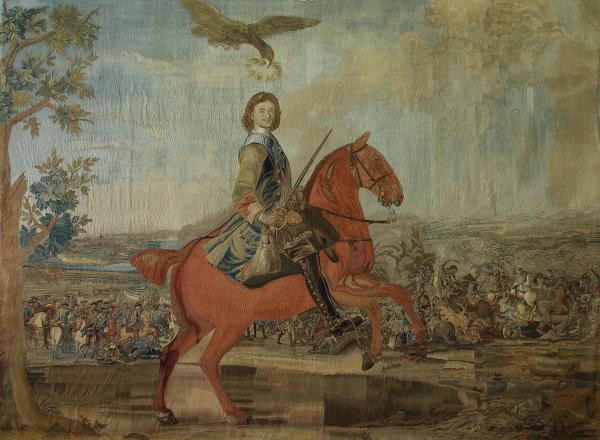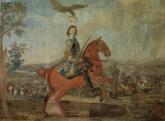Battle of Poltava
Tapestry. 1764
-
Location in museum
The Mikhailovsky Palace,
Room 7
 Open the panorama of the hall in the virtual tour
Open the panorama of the hall in the virtual tour
- Period Late 17th century – the 18th century
- Battle Scenes, Portrait
- Share
The tapestry "Battle of Poltava" is one of the most significant and famous works of St. Petersburg Tapestry Manufactory, which was founded in 1716 on the initiative of Peter the Great. Battle paintings appeared to be a new genre in Russian art, brought to life by the brilliant victories of the Russian army in the Great Northern War. The victory at Poltava was often embodied in all kinds of art, including in weaving. "The Battle of Poltava" is one of the most significant and most famous works of the St. Petersburg Tapestry Manufactory.
In the centre of the tapestry is the equestrian portrait of Peter I, a convincing monumental image of the commander. The figure of the emperor on the rampant bay horse is spectacularly depicted against the background of the battle. The artist and the makers of the tapestry managed to find the necessary degree of generalization and achieve the monumentality necessary for this kind of work, creating an expressive artistic image through the means of carpet making.
Initially, the tapestry was surrounded by a wide frame with the images of the coats of arms of Russian towns. It is difficult to say, when and under what circumstances the tapestry lost this spectacular frame. Until 1863 the St. Petersburg furniture manufacturer Karl Tur owned the carpet. Then until 1912 the carpet decorated the rooms of the Petrovsky palace on Petrovsky island.
The fragments of the frame are currently kept in the State Russian Museum and the Historical Museum in Moscow.
The tapestry is an example of the most interesting monumental Russian decorative art of the 18th century thanks to the mastery of its performance.

